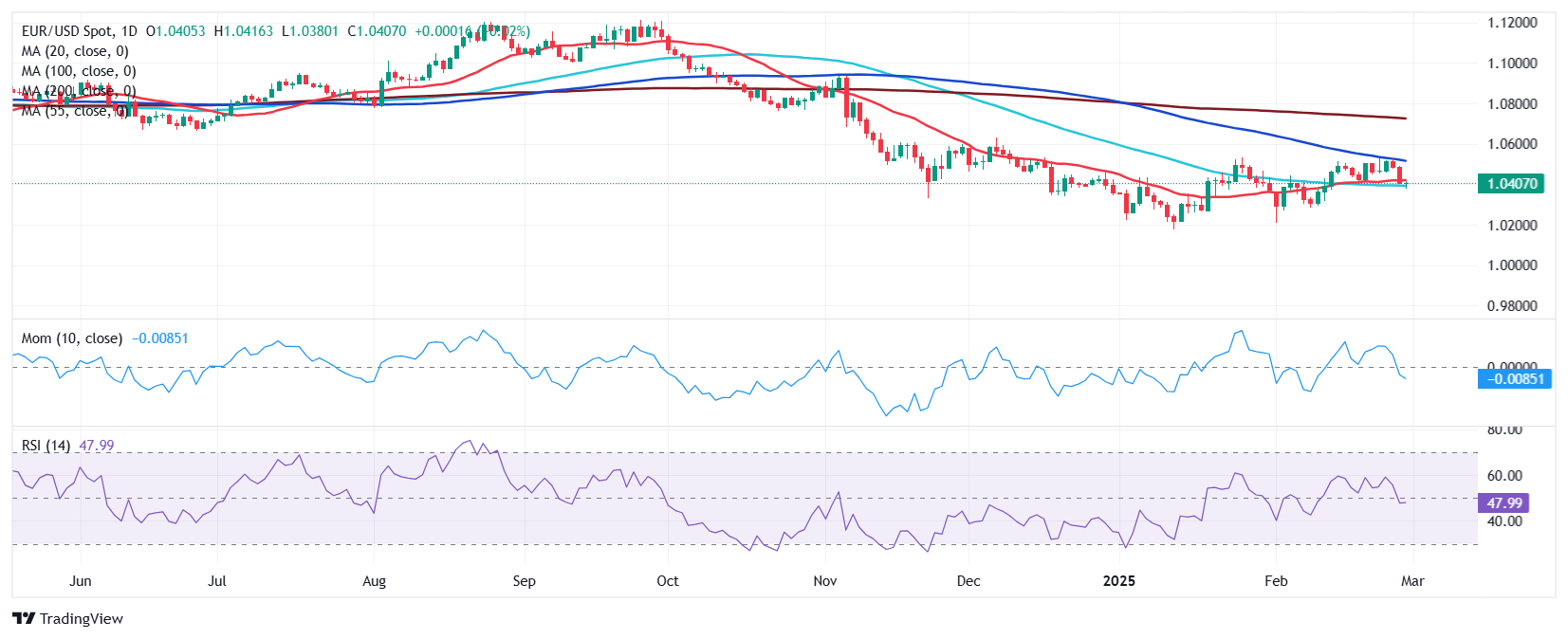- United States President Donald Trump brought back the trade war to the spotlight.
- The European Central Bank is expected to trim interest rates by 25 basis points.
- EUR/USD at risk of falling towards the 1.0200 region amid mounting risk aversion.
After trading choppily for most of the week, the EUR/USD pair plummeted on Thursday, bottoming early Friday at 1.0379, its lowest in over two weeks. It got to bounce modestly from the level ahead of the close, settling at around 1.0400.
The pair attempted to recover the 1.0500 threshold a couple of times throughout the week but quickly retraced from the level.
The US Dollar (USD) was trapped between a generalized cautious mood providing support and tepid United States (US) data fueling concerns about economic progress in the world’s largest economy.
Speculative interest ramped up bets on more Federal Reserve (Fed) interest rate cuts this year. As a result, government bond yields eased, with Treasuries finding renewed demand.
Trade war fears hit hard
Meanwhile, back and forth in the US government tariffs’ plans shook financial boards. US President Donald Trump offered a press conference on Wednesday, with financial markets concluding fresh levies on Canada and Mexico would come into effect in April.
Trump, however, clarified through social media on Thursday that the proposed 25% levies on neighbour countries will come into effect on March 4, as originally planned. Additionally, China will be charged an additional 10% tariff on the same date.
Trump added that reciprocal tariffs starting April 2 “will remain full force and effect” and threatened 25% tariffs on the European Union (EU). Finally, he mentioned the United Kingdom (UK), signalling the kingdom could escape levies if a trade deal is reached.
The German Kiel Institute said that a 25% tariff on EU imports could trigger “economic turmoil” in the country and translate into higher inflation in the region.
US data spurs concerns
On the data front, the US published softer-than-anticipated figures. The Conference Board Consumer Confidence Index declined to 98.3 in February, worsening from the previous 104.1. The Present Situation Index fell to 136.5, while the Expectations Index dropped to 72.94, below the 80 threshold that usually signals a recession ahead for the first time since June 2024.
Furthermore, Q4 Personal Consumption Expenditures (PCE) Prices were upwardly revised, meaning inflation was higher than previously calculated. The annualized Gross Domestic Product (GDP) in the same period was confirmed at 2.3%, as previously estimated. Also, Initial Jobless Claims for the week ended February 22 jumped to 242K, much worse than the 221K anticipated.
Housing-related figures were discouraging, as New Home Sales fell 10.5% in January, while Pending Home Sales in the same month declined 4.6%. On a positive note, Durable Goods Orders jumped by 3.1% in January, while December’s reading was revised from -2.2% to -1.8%.
Finally, the US published the January PCE Price Index on Friday, which declined to 2.5% YoY from 2.6% in December, as expected. The core annual reading printed at 2.6%, easing from the 2.9% posted in December and matching the market’s expectations.
European tepid growth persists
Other than that, EU data also fell short of encouraging. Germany had a Federal Election on February 23. Conservatives won, with the conservative Christian Democratic Union (CDU) leader Friedrich Merz meant to become the next Chancellor. The party got roughly 28% of the votes, which means it would need a coalition to rule the country, although it already progressed on such front with the Christian Social Union (CSU), which came third in the election. The CDU-CSU have governed together four times since World War II, including three times under the leadership of Angela Merkel.
The country released the February IFO survey, which showed Business Climate stayed at 85.2, matching the previous reading while missing the 85.8 expected. Additionally, the country confirmed the Q4 GDP at -0.2%, while Retail Sales rose by 0.2% MoM in January.
The EU confirmed earlier in the week that the Harmonized Index of Consumer Prices (HICP) rose at an annual pace of 2.5%, as previously estimated, while Germany published the preliminary estimate of the February HICP on Friday, which resulted higher than anticipated, up 2.8% from a year earlier, matching the January reading yet above the 2.7% forecast.
What’s next in the docket
The first week of March will be packed in terms of macroeconomic releases. The EU will release the preliminary estimate of the February HICP on Monday, while the US will later unveil the ISM Manufacturing Purchasing Managers Index (PMI) for the same month.
The US ADP Employment Change report and the ISM Services PMI will be out on Wednesday, along with the January EU Producer Price Index (PPI).
The European Central Bank (ECB) will announce its decision on monetary policy on Thursday, with market participants anticipating 25 basis points (bps) trims to main interest rates.
By the end of the week, the focus will shift to the EU Q4 GDP estimate and US employment figures, as the country will release the monthly Nonfarm Payrolls report.
EUR/USD technical outlook
The weekly chart for the EUR/USD pair shows sellers retain control in the long-term perspective. The pair retreated sharply from around a firmly bearish 20 Simple Moving Average (SMA), which heads firmly south far below mildly bearish 100 and 200 SMAs. The Momentum indicator reached its midline but is losing its upward strength right below it, suggesting buyers remain unconvinced. Finally, the Relative Strength Index (RSI) indicator resumed its slide within negative levels, currently at around 42. Still, the pair is ending February with substantial gains, roughly 200 pips up from its 1.0226 monthly opening.
At the same time, the EUR/USD pair daily chart shows that the upside is limited by sellers aligned around a flat 20 SMA, currently at 1.0415. The 100 SMA, in the meantime, contained advances throughout the week, now providing dynamic resistance at around 1.0530. Technical indicators, in the meantime, turned flat with the Momentum right above its 100 level and the RSI at around 47. It is worth adding the pair is posting consecutive lower lows and lower highs, usually a sign of prevalent bearish strength.
Additional declines expose the 1.0320 region, followed by 1.0276, a relevant weekly low. Once below the latter, the 1.0200 threshold comes into sight. Gains beyond 1.0450 could lead to a test of the 100-day SMA at 1.0530, while a clear break higher exposes the 1.0600 mark.

Tariffs FAQs
Tariffs are customs duties levied on certain merchandise imports or a category of products. Tariffs are designed to help local producers and manufacturers be more competitive in the market by providing a price advantage over similar goods that can be imported. Tariffs are widely used as tools of protectionism, along with trade barriers and import quotas.
Although tariffs and taxes both generate government revenue to fund public goods and services, they have several distinctions. Tariffs are prepaid at the port of entry, while taxes are paid at the time of purchase. Taxes are imposed on individual taxpayers and businesses, while tariffs are paid by importers.
There are two schools of thought among economists regarding the usage of tariffs. While some argue that tariffs are necessary to protect domestic industries and address trade imbalances, others see them as a harmful tool that could potentially drive prices higher over the long term and lead to a damaging trade war by encouraging tit-for-tat tariffs.
During the run-up to the presidential election in November 2024, Donald Trump made it clear that he intends to use tariffs to support the US economy and American producers. In 2024, Mexico, China and Canada accounted for 42% of total US imports. In this period, Mexico stood out as the top exporter with $466.6 billion, according to the US Census Bureau. Hence, Trump wants to focus on these three nations when imposing tariffs. He also plans to use the revenue generated through tariffs to lower personal income taxes.

